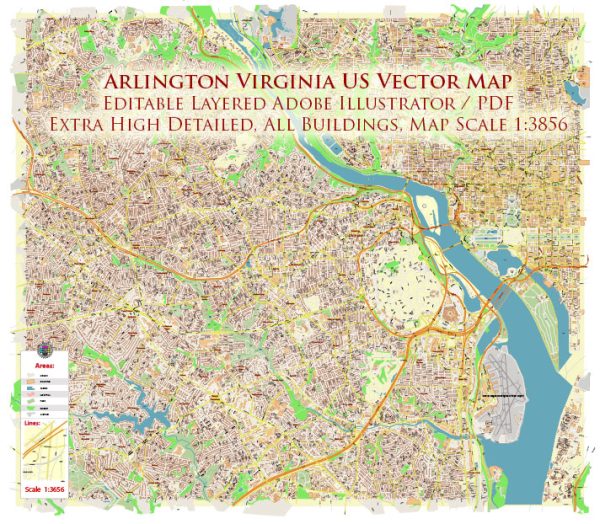Arlington, Virginia, located directly across the Potomac River from Washington, D.C., has a rich political and economic history that is closely tied to the development of the United States as a whole.
Vectormap.Net provide you with the most accurate and up-to-date vector maps in Adobe Illustrator, PDF and other formats, designed for editing and printing. Please read the vector map descriptions carefully.
Here is a detailed overview of Arlington’s political and economic history:
Political History:
- Colonial Era:
- Arlington’s history dates back to the colonial era when it was part of the Northern Neck of Virginia, a land grant from the English Crown.
- American Revolution:
- During the American Revolution, the area played a role in various skirmishes and battles, and George Washington’s adopted son, George Washington Parke Custis, inherited the land that would become Arlington.
- Custis Estate:
- In the early 19th century, George Washington Parke Custis built Arlington House on his plantation. The estate was later passed down to his daughter, Mary Anna Randolph Custis, who married Robert E. Lee.
- Civil War and Arlington National Cemetery:
- Arlington House and the surrounding land became a focal point during the Civil War. Union forces occupied the estate, and it was eventually confiscated. Arlington National Cemetery was established on the grounds, becoming a lasting symbol of national unity and sacrifice.
- Post-Civil War Reconstruction:
- After the Civil War, the region underwent reconstruction. Arlington County was officially formed in 1846, and during this period, the area began to see increased development.
- 20th Century Developments:
- In the 20th century, Arlington became a key part of the Washington metropolitan area. The Pentagon, the headquarters of the United States Department of Defense, was constructed in Arlington during World War II, solidifying its importance in national defense.
- Urbanization and Diversification:
- Arlington experienced significant urbanization and diversification in the latter half of the 20th century. It became home to various government agencies, defense contractors, and businesses.
- County Government:
- Arlington County operates under the county manager form of government. It is an urban county that balances the needs of its residents, businesses, and government entities.
Economic History:
- Agricultural Beginnings:
- Early economic activities in Arlington were primarily agrarian, with farming and plantation economies dominating the landscape.
- Military Presence:
- The establishment of the Pentagon in Arlington during World War II had a transformative impact on the local economy. It brought employment opportunities and spurred growth in the defense and technology sectors.
- Post-War Boom:
- The post-war era saw significant suburban development, and Arlington experienced a population and economic boom. Residential and commercial areas expanded, and the economy diversified.
- Government and Technology:
- Arlington’s proximity to the nation’s capital attracted government agencies and contractors, contributing to the growth of the technology and information sectors. The presence of companies in fields like defense, IT, and telecommunications became a hallmark of the local economy.
- Urban Renewal and Redevelopment:
- In the latter half of the 20th century, Arlington underwent urban renewal projects and redevelopment initiatives. These efforts aimed to enhance the county’s infrastructure, housing, and public spaces.
- Transit-Oriented Development:
- Arlington has been a leader in transit-oriented development, focusing on creating walkable, mixed-use communities around transit hubs. The Rosslyn-Ballston corridor, known for its Metro stations, exemplifies this approach.
- Knowledge-Based Economy:
- In recent years, Arlington has continued to evolve into a knowledge-based economy, with a focus on education, research, and innovation. The presence of universities, research institutions, and tech companies contributes to this trend.
In summary, Arlington’s political and economic history reflects its evolution from a colonial and agrarian landscape to a dynamic and diverse urban center with a strong focus on government, technology, and innovation. The interplay between historical landmarks, government institutions, and economic development has shaped the character of this vibrant Virginia community.


 Author: Kirill Shrayber, Ph.D.
Author: Kirill Shrayber, Ph.D.